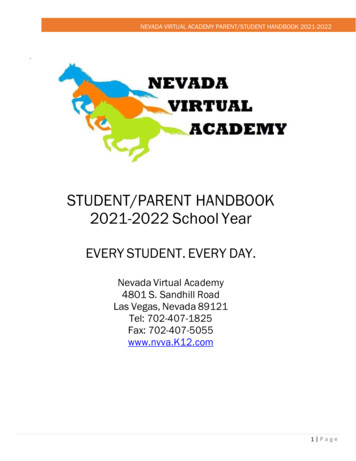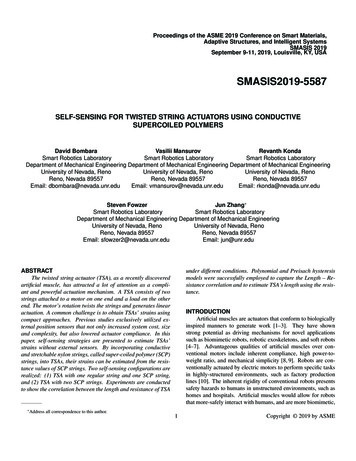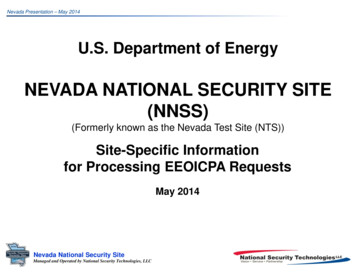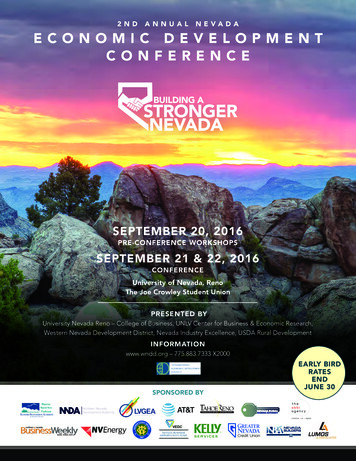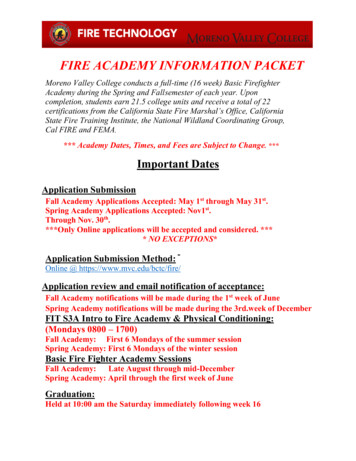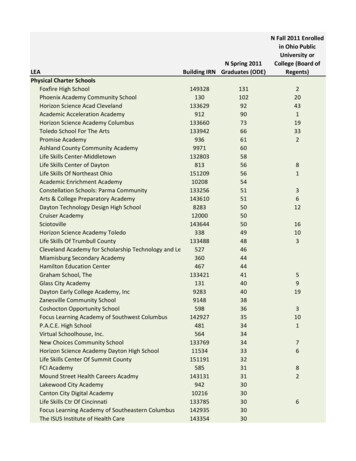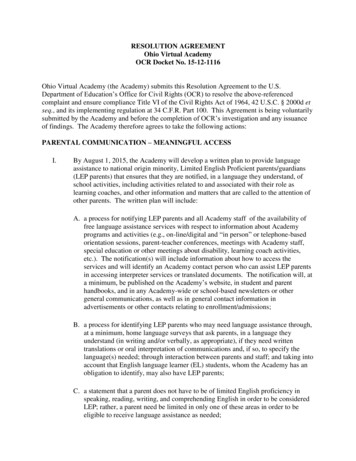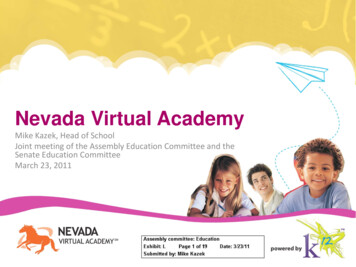
Transcription
Nevada Virtual AcademyMike Kazek, Head of SchoolJoint meeting of the Assembly Education Committee and theSenate Education CommitteeMarch 23, 2011
HistoryNevada Virtual Academy is a Nevada distance education charter schoolsponsored by the Nevada State Board of Education. The Boardapproved NVVA’s initial, or Subchapter 6, charter for grades 4through 8 on March 17, 2007, and on June 29 of the same yearapproved conversion to a full charter.NVVA began operations on August 27, 2007. In August 2008, theBoard gave NVVA permission to expand its class offerings to includegrades K through 3 as well as grade 9.On January 16, 2009, the Board approved NVVA’s new charterapplication for grades K through 12; these grades were added in the2009-10 academic year.L-2
Board of DirectorsCurrent BoardFounding BoardDon Curry, PresidentSharon Kientz, Vice PresidentStephen Walters, SecretaryWilliam BukoviWilisha DanielsRichard GordonThad SimmonsBill Bukovi, PresidentDon CurryMike KazekThad SimmonsL-3
National Trends in On-Line PublicEducationOnline learning in grades K-12 is one of the fastest growing trends ineducation. The North American Council of Online Learning (iNACOL) recommendsa state policy framework which includes equal access to full-time andsupplemental online learning programs for students across each state. As of Fall 2010, 27 states plus Washington, DC, have at least onfulltime online school operating statewide. At least 200,000 studentsare attending fulltime online schools, while an additional 1.5 millionstudents are taking one or more online courses. “Keeping the Pace 2010” – an annual review of policy and practice by theInternational Association for K-12 Online Learning (iNACOL)K12 is the largest operator of high quality, full-time online schools,serving more than 80,000 students in 27 statewide online schools,including students at Nevada Virtual Academy.L-4
Open EnrollmentHeadcount Day, Sept 2010 eWhite PineTotal38352,1025553043011108128322302152,742L-5
Enrollment GrowthL-6
Ethnicity ReportIndian/AlaskanAsianHispanicor otalK13221411069156Grade 11015811028135Grade 225241918415150Grade 3310231631199183Grade 414112221099158Grade 5332821213812207Grade 6373220317011246Grade 76125528223310346Grade 84164529226812376Grade 956332421559234Grade 10354117217015253Grade 1145231921165174Grade 12242315478613238803752522718481302750TotalL-7
NVVA’s Curriculum Use the K 12, Inc curriculum, which is approved by the Departmentof Education and aligns with Nevada standards Is staffed by highly qualified, licensed educators Combines powerful technology with great teaching Can be delivered anywhere internet access is available Combines both synchronous and asynchronous instruction Is not bound by the “bell schedule” Provides students and families with a choice Creates learning opportunities different from than the brick andmortar school Creates closer, more individualized attention and relationshipsbetween students, teachers, and parentsL-8
Student Assessment afterEnrollmentScantron Testing to determine grade levelDevelopment of individualized academic planfor each studentL-9
Individualized Daily PlanL-10
Student StoriesL-11
Innovations in Teaching“The quality of an education system cannot exceed thequality of its teachers.”“The only way to improve outcomes is to improveinstruction.”How the Worlds’ Best Performing School Systems Come Out On TopMcKinsey, 2007L-12
Role of the TeacherEvery student is assigned to a state-certified public school teacher. Teachers workremotely and are responsible for overseeing and managing student learning:––––––Teachers assign lessonsTeachers provide instruction, guidance and support.Teachers track student attendance and academic progressTeachers evaluate student workTeachers develop a strong partnership with parent or responsible adultIn consultation with parent, teachers: Recommend remedial or enrichment programs Placement and promotion decisions– Teachers communicate regularly with their students via phone, email, and face to facemeetings, including academic workshops.– Organize social and academic outings; promote school community– Participate in regular training and professional developmentL-13
Teacher Training, Support andProfessional Development Teacher Support– Teacher Help Desk– Teacher Support Hotline– Teacher email assistance– Teacher Support Website Virtual National Teacher Training (VNTT)– K-8 and HS Online Teacher Onboarding– 40-50 hours synchronous and asynchronous training course National Professional Development– Online Synchronous Instructor (OSI) Certificate– Content area focused sessionsL-14
New Teacher Training – “Onboarding” 40 to 50 hours of training46 learning goals and 134 objectives11 units containing 65 lessonsSynchronous Instruction (7 live sessions)Topics include: K12 and You Students and Families Instructional Model Curriculum and Placement Synchronous and Asynchronous Instruction Tools and Techniques Online Communication Working From Home Ready to teach on Day 1 of schoolL-15
Accountability Students are assessed daily in every lessonStudents take unit reviews and finalsTeachers visit with families and review workK12’s state-of-the-art Online School allows teachers totrack student progress Students are required to participate in state proficiencyexams, such as CRTs and HSPE, in proctored settings atlocations all over the state Parents sign time sheet documenting hours spentworking on lessons Students must make adequate progress in the coursesL-16
Community Building and SocializationSchool Outings and online communities: Throughout the school year, students are invited to participatein school outings, field trips (to historical sites, museums, zoos, etc.), picnics, and social events. Weexpect that local clusters of students and parents will keep in touch and get together on a regularbasis in their areas. With online discussions and forums, new types of communities can be formedthat are based not on geography and place but on shared interests.Student Clubs: NVVA sponsors many student clubs, including National Honor Society, Chess Club,Reading Club, Science Club, etc.Art Competitions: Each school year, NVVA sponsors an art contest for all students enrolled in K12 virtualacademies.Community Chest: is a website which provides a wealth of information for parents and families aboutways to interact with each other and the school, online and off. It includes discussion boards, blogs,games, competitions, and many other ways for students and families to interact.Family Directory: is an opt-in, web-based tool enabling parents of NVVA students to organize online andoffline social activities for their children. Parents can run searches based on criteria such as theirchild’s location, age, or interests (e.g. hobbies or sports) to locate and contact other parents ofchildren with similar interests.Community Boards: NVVA hosts at secure, monitored Community Boards to create a safe environmentfor interaction between families.L-17
Teaching Tomorrow’s Teachers Student teaching Discussions with UNLV re: certificate inteaching in the distance education modelL-18
Mike KazekHead of SchoolNevada Virtual Academy702-407-1825 x7001mkazek@k12.comL-19
Nevada Virtual Academy is a Nevada distance education charter school sponsored by the Nevada State Board of Education. The Board approved NVVA's initial, or Subchapter 6, charter for grades 4 . Students take unit reviews and finals Teachers visit with families and review work K12's state-of-the-art Online School allows teachers to

